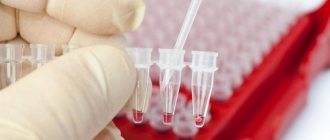Activated partial thromboplastin time, or aPTT, is the time it takes for a blood clot to form after calcium chloride and other reagents are added to the plasma. It reflects the work of the so-called internal pathway and the general cascade of the human blood coagulation system and is the most sensitive indicator of blood coagulation.
Synonyms Russian
Activated partial thromboplastin time, cephalin-kaolin time.
English synonyms
Partial Thromboplastin Time (PTT), Activated Partial Thromboplastin Time, aPTT, APTT.
Research method
Side scatter detection method, end point percentage determination.
Units
Sec. (second).
What biomaterial can be used for research?
Venous blood.
How to properly prepare for research?
- Do not eat for 12 hours before the test.
- Avoid physical and emotional stress 30 minutes before the test.
- Do not smoke for 30 minutes before the test.
General information about the study
Activated partial thromboplastin time (aPTT) characterizes the intrinsic pathway of blood coagulation. APTT is the time it takes for a clot to form in a blood plasma sample after adding special activators of this process. In this way, the degree of influence of blood clotting factors on the formation of a blood clot is assessed.
The duration of APTT depends on the level of high molecular weight kininogen, prekallikrein and coagulation factors XII, XI, VIII and is less sensitive to changes in the amount of factors X, V, prothrombin and fibrinogen. APTT is determined by the duration of blood clot formation after calcium and partial thromboplastin are added to the blood sample. An increase in aPTT duration is associated with an increased risk of bleeding, while a decrease is associated with thrombosis. This indicator is used separately to monitor therapy with direct anticoagulants (heparin).
What is the research used for?
- For the diagnosis of hemophilia.
- To monitor heparin anticoagulant therapy.
- For the diagnosis of deep hypofibrinogenemia, dysfibrinogenemia and disorders of fibrin monomer polymerization.
- To determine the patient’s predisposition to bleeding (as part of preoperative procedures).
When is the study scheduled?
- If the patient has bleeding or bruising of unknown origin, thromboembolism or disseminated intravascular coagulation, which can cause both bleeding and blood clots.
- When carrying out heparin therapy or when transferring a patient from heparin therapy to long-term treatment with warfarin.
- As part of a preoperative examination to identify the body's tendency to bleed, especially if the proposed operation is associated with a large loss of blood or the patient's clinical history indicates earlier bleeding.
- In the treatment of myocardial infarction.
What do the results mean?
Reference values: 21.1 - 36.5 sec.
An increase in aPTT indicates a tendency to bleed: blood clotting lasts longer than usual, which often indicates a deficiency in one of the coagulation factors or the effect of some inhibitor on the body's ability to form clots.
What can influence the result?
- The presence of impurities of direct anticoagulants (in particular, heparin) in the blood sample
- High concentration of lipids (fats) in the blood, for example, after eating a fatty meal the night before the test
How to prepare for donating blood for a hemostasiogram
Blood is donated on an empty stomach, from a vein. 12 hours before hemostasis, you must adhere to a diet excluding fatty and protein foods. The last meal (light snack) is possible 4 hours before blood sampling. It is prohibited to drink alcohol the day before the test. It is recommended to replace any drinks with water. This is done so that sugar does not affect the overall picture.
If you are taking medications that may affect the results of the data, this must be indicated when taking the test. This will be taken into account when deciphering the testimony.
It is not recommended for women to undergo the procedure during menstruation.
It is also better to refrain from playing sports in the previous day, to avoid stress and overexertion. Smokers are advised to give up cigarettes during this time.
The process of drawing blood also affects the accuracy of the result. When collecting from a vein, it is better to use a vacuum system. If this is not possible, then a syringe is used and the blood is allowed to flow on its own.
Indicators
It is extremely problematic to independently understand the results obtained without special education. Based on the results of the hemostasiogram, you must make an appointment with a hemostasiologist or hematologist.
The form indicates the results obtained and the norms given in two columns. These are indicators of prothrombin, aPTT, prothrombin time, prothrombin index, fibrinogen, platelet function, thrombin time, RKMF, INR.
In a detailed analysis, an additional test for D-dimer, lupus anticoagulant, and antithrombin III is often prescribed.
Tests during pregnancy
Hemostasiogram
Pregnancy management
Hemostasiologist during pregnancy
Normal indicators
According to APTT data, the rate at which blood clots is assessed. Ideally, it should be from twenty-four to thirty-six seconds, laboratory referents differ - ADD. With a lack of vitamin K, this time will be longer. In this case, you should be wary of severe blood loss from cuts and deeper wounds. If the time, on the contrary, is less, this means that there is a risk of a blood clot. In this case, during pregnancy the baby will not receive enough nutrients.
The line with data on prothrombin contains the same results, but in percentage equivalent. So prothrombin should be from 78 to 95 to 105 percent.
Fibrinogen should normally be from two to four grams per liter; during pregnancy it can increase.
With normal levels, antithrombin III ranges from 71 to 115 percent,
Exact standards in laboratory abstracts. If deviations are greater or lesser, blood clots or bleeding may appear.
Thrombin time should be from eleven to eighteen seconds, and prothrombin time should be from fifteen to seventeen.
Platelet function is from 30 to 50%, a decrease in function indicates the risk of bleeding or the effectiveness of antiplatelet therapy, an increase indicates an increase in the aggregation function of the blood.
Hemostasiogram in pregnant women
Pregnant women need to especially carefully monitor blood clotting. This will avoid complications during the birth process, as well as throughout pregnancy.
During pregnancy, a hemostasiogram is taken once per trimester or more often if indicated.
The attending physician may prescribe additional tests if there is a threat of miscarriage, also to assess the effectiveness of anticoagulant therapy. It is also recommended to do a hemostasiogram in case of high blood pressure, edema, the presence of protein in a urine test, before surgery, or when prescribing OCs and HRT.
If test results are poor, consultation with a hemostasiologist is necessary.
Do not be alarmed if you suddenly discover that the coagulation rate is slightly higher than required. In pregnant women, this may also be a normal option. This may happen due to changing hormonal levels. For women in an interesting position, it is unstable and can change more than once. The result may be affected by the appearance of an additional circulation that connects the uterus and placenta and an increase in blood volume.
Conventional and advanced hemostasis analysis
This diagnostics in Yeysk can be carried out at the Sensitive LCC both according to the regular program and in an expanded form. The standard hemostasiogram includes the following indicators:
- thrombin and prothrombin time;
- prothrombin level;
- fibrinogen level;
- platelet count in peripheral blood;
- soluble complexes of monomers and fibrin.
An advanced analysis for hemostasis adds to the above indicators the study of such parameters as:
- antithrombin III,
- lupus anticoagulant and D-dimer,
- von Willebrand factor.
Hemostasis test for pregnant women
The threat of large blood loss during childbirth is the main criterion that guides the obstetrician-gynecologist when prescribing a hemostasis test for a pregnant woman. However, in addition to this, a hemostasiogram can be prescribed by the doctor monitoring the course of pregnancy in the case when the patient develops gestosis or has uterine hypertonicity, there is a threat of miscarriage, or there is a delay in intrauterine development of the child. A hemostasis test is usually prescribed even if the pregnancy is multiple. When observed by an obstetrician-gynecologist in a medical clinic, a woman undergoes all necessary examinations during pregnancy.
APTT (activated partial thromboplastin time) (determination in blood plasma)
The value of tests
What does a deviation from the normal APTT indicate?
If a person has liver disease, or there is a deficiency of vitamin K in the body, or the presence of anticoagulants in the blood, the APTT will be higher than normal values, and there is a high risk of blood loss.
A decrease in the indicator indicates excessive blood clotting, which means that the internal coagulation mechanism has been activated in the vessels, which will lead to acute blockage of the vessel with a thrombus and impaired circulation.
APTT is higher than normal when:
- hemophilia A, B, C (hereditary diseases when hemorrhages occur in joints, muscles, internal organs);
- von Willebrand's disease;
- congenital deficiency of prekalykrein and kinin;
- administration of heparin or streptokinase;
- with blood loss and blood transfusion;
- presence of lupus anticoagulant in the blood;
- antiphospholipid syndrome;
- chronic glomerulonephritis;
- systemic lupus erythematosus;
- treatment with anticoagulants (Warfarin, Sincumarin, etc.);
- vitamin K deficiency (intestinal diseases, long-term antibiotic treatment, poor diet);
- low fibrinogen content in the blood;
- liver diseases (liver failure, cirrhosis);
- II and III phases of DIC syndrome;
- deficiency of coagulation factors (II, V, VII, VIII, IX, X, XI, XII);
- connective tissue diseases;
- postpartum, postoperative bleeding;
- acute leukemia.
APTT is below normal when:
- activation of the internal coagulation mechanism during thrombosis, thromboembolism, bleeding. This may be due to the immunity of factor V to activated protein C, increased levels of factor VIII or activated coagulation factors: thromboembolism of various locations (heart, lungs, brain), thrombosis: vessels of the lower extremities, thrombosis of placental vessels during its abruption, etc.;
- with DIC syndrome (hypercoagulable phase);
- in women when taking oral contraceptives or during a normal pregnancy;
- predisposition to hemophilia;
- the presence of inflammatory foci in the body.
Determination of APTT in pregnant women
Pregnant women require special attention and accurate diagnosis of abnormalities in any tests. The APTT indicator is no exception. If the aPTT is reduced, a blockage of the vessel may occur at any time, and blood circulation between the baby and mother may be impaired. When the aPTT is prolonged, there is a high risk of bleeding, placental abruption and fetal death. Therefore, when carrying a child, a blood test for APTT should be done every three months. With repeated miscarriage and infertility, a blood test for aPTT helps to identify the causes of these conditions and prescribe the correct treatment to avoid negative consequences in the future.
Indications for hemostasis analysis
A bleeding disorder is primarily a serious contraindication for any surgery, so a hemostasis test is required before surgery. This diagnosis is also necessary for pregnant women, since during childbirth, a blood clotting disorder can pose a threat to the woman’s life. In addition, the doctor can prescribe this diagnosis in Yeysk for the following indications:
- Moderate to severe liver diseases: the liver is a hematopoietic organ.
- Diseases of the endocrine system: the blood clotting process is affected by the level of hormones.
- Pathologies of the cardiovascular and urinary systems.
- Autoimmune diseases.
A doctor may prescribe this type of laboratory diagnostics in cases where the patient has frequent nosebleeds, bleeding gums, bruises and hematomas even from a minor mechanical impact (minor bruise, pressure). For varicose veins, this test is also prescribed, as it allows us to identify the likelihood of a blood clot.









